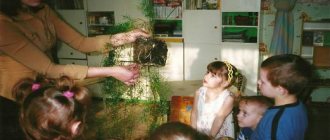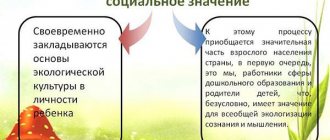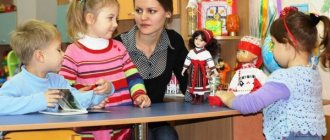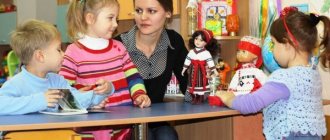Pedagogical advice: Environmental education in kindergarten
Pedagogical Council "Environmental education in kindergarten."
Goal : to improve work in kindergarten to form the foundations of environmental culture in preschoolers. Progress of the teaching council: The amazing world of nature greets the child with a sea of sounds and smells, riddles and secrets, makes him stop, listen, look closely, and think. A field, a meadow, a quiet river, a tiny puddle have their secrets. But wherever the kindergarten is located: in a noisy city or in a quiet village, beyond the Arctic Circle or in the steppe, a teacher who loves nature helps children take their first steps into an unknown country called nature. I invite you to talk about environmental education of children, share your experiences and ideas to improve the efficiency of the educational process. What does the term "Ecology" mean? The word “ecology” itself is derived from the Greek “ekos” - “house” and “logos” - the science of the interactions of living organisms and their communities with each other and with the environment. The term was first proposed by German biologist Ernst Haeckel in 1866. Some possible definitions of the science of “ecology”: • Ecology is the knowledge of the economy of nature, the simultaneous study of all the relationships of living things with organic and inorganic components of the environment... In a word, ecology is a science that studies all the complex relationships in nature. • Ecology is the science of the environment and the processes occurring in it. What is meant by environmental education of preschool children? Environmental education of preschool children involves: – fostering a humane attitude towards nature (moral education); – formation of a system of environmental knowledge and ideas (intellectual development); – development of aesthetic feelings (the ability to see and feel the beauty of nature, admire it, the desire to preserve it); – participation of children in activities feasible for them to care for plants and animals, to preserve and protect nature; – environmental education is a system aimed at the formation of the principles of environmental culture and the development of environmental culture in children and adults; – the system of environmental education is the creation of conditions, certain content, methods and forms of work with children and parents. Why, in your opinion, does environmental education need to start from preschool age? Preschool age is the most favorable period of environmental education. It is at this age that vivid, imaginative emotional impressions, the first natural history ideas accumulate, and the foundation of a correct attitude towards the world around us and a value orientation in it is laid. Love for nature, a conscious, careful and interested attitude towards it in every person should be cultivated from early childhood in the family and kindergarten. What is the role of the teacher in the environmental education of a preschooler? Environmental education of preschoolers should be carried out by a teacher who himself has knowledge in the field of ecology, who loves nature and cares about it. It presents a complex of environmental knowledge in an accessible, exciting form based on the principle of developmental education and aimed at developing the child’s personality. Takes into account interest and age characteristics. In what types of children's activities is it possible to consolidate environmental knowledge? In the process of environmental education, the following types of activities can take place: – role-playing game, reflecting various events in nature or the activities of adults; – practical activities to create or maintain conditions for living objects in the green area of the kindergarten (work in nature), as well as activities to restore objects (repairing toys, books); – children's creativity based on impressions of nature or the activities of people in nature; – communication with nature, contact with objects of flora and fauna; – experimentation: practical cognitive activity with natural objects; – speech activity (questions, messages, participation in conversation, dialogue); exchange of information, impressions, clarification of ideas about nature using words; – observation (independent cognitive activity), providing information about the nature and activities of people in nature; – viewing books, paintings, television programs with natural history content, activities that contribute to obtaining new and clarifying existing ideas about nature; – project activities. In order to develop in children: the need to communicate with representatives of the animal and plant world, cognitive interest in them, the ability to see and understand beauty, the need for self-expression in creative activity, conditions are created in kindergarten where children can, with daily free access, replenish their knowledge, realize the need to communicate with nature. Message from the teacher “Creating an ecological and developmental environment in preschool educational institutions.” Business game Your task is to show knowledge about the life of flora and fauna, the state of the weather, signs according to the folk calendar. 1 part. Warm up. Participants take turns answering the leader’s question. Questions for the first team 1. How is rain formed? (Rain is formed by the condensation of water vapor, which collects in clouds, transforming into clouds, from which drops of water fall onto the surface of the earth. This phenomenon is a consequence and an integral part of the water cycle in nature.) 2. What is fog? (Fog is a form of release of water vapor in the form of microscopic drops or ice crystals, which, collecting in the ground layer of the atmosphere (sometimes up to several hundred meters), make the air less transparent.) 3. Which tree and shrub plants bloom at the same time during spring? and leaf buds? (The maple blooms at the same time as the leaves bloom.) 4. Which trees begin to flow sap the earliest? (At birch and maple). 5. Why don’t cuckoos build nests and hatch chicks? (She picked up this habit a long time ago, because she has evolutionarily adapted to this parasitic method of breeding chicks. Despite its large size, the cuckoo lays small eggs so that small birds do not realize that they have a foundling in their nest. Each species of cuckoo chooses the nest of those birds , whose eggs resemble her own in color, because if they notice the catch, the owners will simply throw away someone else’s egg). 6. Why do bunnies always tremble? (Heat develops in the trembling muscles, which bunny rabbits use to warm themselves.) 7. Which herbaceous plant has pink young flowers and purple flowers in old ones? (At the lungwort). 8. What is a squirrel's nest called? (Gayno. The spherical outside of the nest is disguised with leaves. Spruce branches, the inside is lined with moss, grass, wool, sometimes finely plucked bast. A caring squirrel mother has from three to five nests. When parasites breed in a warm nest, the squirrel transfers the squirrels to another nest. She does the same in a moment of danger.) Questions for the second team 1. How is a rainbow formed? (Rainbows are usually explained by simple refraction and reflection of the sun's rays in raindrops). 2. How can you tell from the snow in a ravine where is south and where is north? (On the southern slope of the ravine, the snow melts faster, so there is less of it there. On the northern slope, the snow melts more slowly, and there is more of it there). 3. Which tree’s leaves never change color and fall green in the fall? (Alder leaves). 4. Which butterflies wake up in the spring and fly out first? (In the spring, the first to fly are urticaria, lemongrass, cabbageweed, and hawthorn). 5. Why do swifts never land on the ground? (On the ground, swifts are helpless - their short legs are adapted only for crawling. A swift is also not able to take off from the ground on its own - its long wings hit the ground when flapping. The absence of a hind finger does not allow it to grasp a branch). 6. Which tree “changes clothes” either gray-silver or green? (Aspen. It’s its leaves that tremble. Aspen leaves tremble even in calm weather, since their petioles in the upper part are strongly flattened.) 7. Which animal is the cleanest? (Badger. Near the hole it is always clean, the badger makes a toilet - deep holes - a few meters from the hole. When the hole is full, the badger buries it and makes a new one. When he goes hunting. He cleans the fur from the earth stuck to it, straightens the hairs crushed in the hole .). 8. Why do nettles “burn”? (The hairs on nettle leaves contain formic acid. When you touch the skin, the tip of the hair breaks, the walls of the hairs containing silica make a wound on the skin, the liquid pours onto the wound and causes a burning sensation.) Part 2. Legends about plants. Plants have played an important role in the life of all peoples since ancient times. There are many different stories associated with them. Each plant has its own history, and a very ancient history has turned into a legend. Teams are offered photographs of plants; participants must determine their name and tell a legend about them. Iris The name of the plant comes from the Greek word iris - “rainbow”. According to ancient Greek mythology, the goddess of the rainbow Iris (Iris) fluttered across the sky on light, transparent, rainbow wings and carried out the orders of the gods. People could see it in raindrops or on a rainbow. A flower was named after the golden-haired Iris, the shades of which were as magnificent and varied as the colors of the rainbow. Viburnum There is such a legend about viburnum. There were once viburnum berries that were sweeter than raspberries. A beautiful girl fell in love with a proud blacksmith, who did not notice her and often wandered through the forest. Nothing helped, and then she decided to burn that forest. The blacksmith came to his favorite place, and everything there burned down. Only one viburnum bush remained, watered with burning tears. And under the bush the blacksmith saw a tear-stained beauty. His heart grew attached to the girl, he fell in love, but it was too late. Along with the forest, the girl’s beauty quickly burned away. And viburnum restored the guy’s ability to respond to love, and in his old age he saw the image of a young beauty in his hunched old woman. But since then, the viburnum berries began to taste bitter, like tears of unrequited love. And there was a belief that a bouquet of viburnum, applied to an aching heart in love, soothes the pain. Lily Ancient Greek myths attributed divine origin to the lily. According to one of them, one day the goddess Hera fed the baby Ares. Drops of splashed milk fell to the ground and turned into snow-white lilies. Since then, these flowers have become the emblem of the goddess Hera. Among the ancient Egyptians, the lily, along with the lotus, was a symbol of fertility. Christians also adopted their love for her, making her a symbol of the Virgin Mary. The straight stem of the lily represents her intelligence; drooping leaves - modesty, delicate aroma - divinity, white color - chastity. According to legend, the lily was held by the Archangel Gabriel when he notified Mary of the imminent birth of Christ. Birch In Russia, birch has been a symbol of grace and purity since ancient times, which personifies Russian nature and Russian woman. One of the legends tells about a beautiful mermaid who lived in a forest lake. At night she came out of the water and frolicked under the moon. However, as soon as the first rays of the sun appeared, the mermaid immediately dived into her cool home. One day she started playing and did not notice how the young sun god Khors appeared in the sky on his solar chariot. He saw the beauty and fell madly in love with her. The mermaid wanted to hide in the lake, but the golden-haired god did not let her go. So she remained standing forever, turning into a beautiful white-trunked birch tree. Part 3. Breaking ring “Weather Bureau” Teams are given envelopes with leaflets. On some the beginning of the sign is written, on others - the continuation. Participants must quickly and correctly collect folk signs. An abundance of snow in January means a rainy summer. Late flowering of rowan - for a long autumn. Abundant dew on the grass means clear, hot weather. The titmouse begins to squeak in the morning - it means frost. Clover folds its leaves to indicate an approaching storm. Lots of berries - for a cold winter. Frogs croak - it means rain. If lightning flashes in early spring, but thunder is not heard, there will be a drought in the summer. Part 4 Solving pedagogical situations. 1. Ira walked home from kindergarten through a park planted with currant bushes and loudly told her mother how the whole group watered them here. But the mother was busy with her own thoughts. - Why are not you listening to me? - Ira asked and pulled out her hand. - What kind of whims is this?! - the mother flared up and, breaking a young currant branch, whipped the girl with it. And then she said angrily: “Who needs your troubles, it’s just a child’s game!” Without you, there will be enough conservationists. What negative consequences could the mother’s action have? 2. In the kindergarten area, the girls play shopping and replenish the assortment of “products” by picking off plants: yellow acacia pods - “beans”, chamomile heads - “sweets”, etc. Irina Petrovna came up and praised: “Well done! Well thought out! »Name the teacher’s mistakes. What would you do in this situation? Summing up the results of the teachers' meeting. Discussion of draft decisions.
We recommend watching:
Analytical report of the preschool educational institution on the organization of work. Section "Environmental Education" Encyclopedia - one of the forms of introducing preschoolers to the natural world of their native land Ecological trail in kindergarten Musical lesson in the senior group on the topic: Winter
Similar articles:
Ecology in music
Plot-based didactic games on ecology in kindergarten for middle group children
Ecological holidays and leisure activities in preschool educational institutions. Scenarios
Report to the teachers' council "Environmental education of preschool children"
Marina Borisova
Report to the teachers' council "Environmental education of preschool children"
Content.
1. Introduction.
2. Environmental education of preschool children.
3. Methods and techniques of environmental education of preschool children.
“A man became a man when he heard the whisper of leaves and the song of a grasshopper, the murmur of a spring stream and the ringing of silver bells in the bottomless summer sky, the rustle of snowflakes and the howling of a blizzard outside the window, the gentle splash of a wave and the solemn silence of the night - he heard, and, holding his breath, listens hundreds and thousands of years of wonderful music of life.”
V. A. Sukhomlinsky.
1. Introduction.
The ecological state of our planet and the trend of its deterioration require that living people understand the current situation and have a conscious attitude towards it. Environmental problems are common to all continents and states. There are them in Russia too - each region has its own.
Russians know firsthand about the progressive deterioration in the health of adults and children. As a result of soil, water and air pollution, people eat poor-quality foods, drink bad water, and breathe air with a large admixture of exhaust gases.
Environmental problems and the need to overcome them have given rise to a new direction in education – environmental . It is important for each of us to understand how a person is connected with nature and how he depends on it, what patterns exist in nature and why humanity has no right to ignore them.
Ecology emerged as a special branch of science in the 19th century. At that time, it was only a part of zoology and examined the relationships of animals, communities with each other and with the environment. ecology itself was introduced by the German naturalist Ernst Haeckel. It was defined as the science of the relationships of living organisms with the environment and with each other. Translated from Greek, “ ecology” is the science of home, dwelling (“oikos” - house, “logos” - science). Now this direction is called biological, or classical, ecology. Of course, ecology is not an easy science. But in order to understand it and meaningfully work in the field of environmental education , you first need to remember four laws, formulated in popular form by the American scientist Barry Commoner:
• everything is connected to everything;
• everything disappears somewhere;
• everything is worth something (nothing is given for free);
• nature knows best.
In preschool childhood, the child acquires the foundations of personal culture, its basis, corresponding to universal spiritual values. The basis of personal culture includes the child’s orientation in four main spheres of reality - nature, objects created by human hands, phenomena of social life, and activity in oneself. At preschool age, mastering the basics of environmental knowledge is most promising, since it is at this age that the child perceives nature very emotionally and pays attention to features of nature that an adult would not even notice. A child is able to be surprised by what surrounds him and asks a lot of questions about plants and animals. He perceives animals as equals, sympathizes with them, and empathizes with them. It is this opportunity that should be used as fully as possible for the purposes of environmental education.
2. Environmental education of preschool children.
The authors of various programs and manuals offer various formulations of the goals and objectives of environmental education of preschool children: “education of the principles of ecological culture” (S. N. Nikolaeva, “formation of a certain level of conscious attitude, expressed in behavior, attitude towards nature, people, oneself, place in life "(N.A. Solomonova, education of a responsible attitude towards nature (A.V. Koroleva, education in a child’s need to preserve and improve nature, development of his creative potential (N.E. Orlikhina, “formation in children of a consciousness corresponding to this problem”) (G. Filippova) E. F. Terentyeva suggests that “ecological education of preschool children can be considered as a process of forming a consciously correct attitude towards the environment .” S. N. Nikolaeva believes that the formation of the principles of environmental culture is “the formation of a conscious - a correct attitude towards nature in all its diversity, towards people who protect and create material and spiritual values on the basis of its wealth.”
The goal of environmental education is the formation of a new type of person with new ecological thinking, capable of realizing the consequences of his actions in relation to the environment and able to live in relative harmony with nature. Already at an older age, children without much effort acquire a complex of environmental knowledge if the knowledge is presented in an accessible, exciting form and if the child’s interest in natural phenomena is taken into account.
To achieve this goal, it is necessary to solve a number of interrelated problems in the field of education, upbringing and development of the child :
• formation of a system of elementary scientific environmental knowledge that is understandable to a preschool child (primarily as a means of developing a consciously correct attitude towards nature);
• development of cognitive interest in the natural world;
• formation of initial skills and habits of environmentally literate behavior that is safe for nature and for the child himself;
• fostering a humane, emotionally positive, careful, caring attitude towards the natural world and the environment in general; developing a sense of empathy for natural objects;
• formation of skills and abilities to observe natural objects and phenomena;
• formation of an initial system of value orientations (perception of oneself as a part of nature, the relationship between man and nature, the intrinsic value and diversity of meanings of nature, the value of communication with nature);
• mastering basic norms of behavior in relation to nature, developing skills for rational environmental management in everyday life;
• developing the ability and desire to preserve nature and, if necessary, provide assistance to it (care for living objects, as well as skills in basic environmental activities in the immediate environment;
• formation of basic skills to foresee the consequences of some of their actions in relation to the environment.
Any education, be it environmental , aesthetic, moral, must be an education of the heart, which gives rise to feelings, thoughts and actions. All the great teachers of the world talk about this. The heart is the source of humanity in man. “The years of childhood are, first of all, the education of the heart,” wrote V. Sukhomlinsky. Environmental education of preschool children without education of the heart is impossible . And the time limit for this is short - seven years; it will be extremely difficult to do this further.
One of the tasks of environmental education is to form in the child an idea of man not as a master, a conqueror of nature, but as a part of nature that depends on it. It is necessary to eradicate the consumer attitude towards nature. Currently, most preschool children have formed a clear division of animals into bad and good, evil and kind, harmful and useful. Many works of art and cartoons also contribute to this. In many of them, predators are depicted as evil, bad. They want to eat “good” hares, piglets, etc. As a rule, hares defeat wolves and are left to live in the forest alone, without evil predators. Many children are convinced that a predatory animal is bad, it is not needed in nature, and that the most beautiful forest is a forest without wolves. From an environmental point of view, in nature there are no bad and good, harmful and useful. Every animal and plant does its job, plays its role in nature. Everyone is needed equally - both wolves and hares. A forest without predators will not be a balanced ecosystem and will eventually begin to degrade. Consequently, one of the important tasks of environmental education is to develop an equally caring attitude towards all living organisms, regardless of whether we like them or not.
The subject environment of a preschool child includes various natural objects, so his familiarization with plants, animals, and inanimate natural phenomena is a natural process of learning about the world around him and acquiring social experience. This process, which takes place under the deliberate guidance of adults, may have different scientific basis.
An ecological worldview is a product of education; its formation occurs gradually over many years of a person’s life and teaching. The beginning of this process falls on the period of preschool childhood, when the first foundations of world understanding and practical interaction with the subject-natural environment are laid.
Environmental education of preschoolers is an introduction to nature for children, which is based on an ecological approach, and the pedagogical process is based on the fundamental ideas and concepts of ecology . Human interaction with nature is an extremely pressing problem of our time. At any time of the year, an observant person, walking through a field or forest and studying the tracks of an animal, will see how interesting the world around him is changing. The swamp becomes the scene of many events and incidents, and the overgrown bend contains an entire underwater world.
Rivers, meadows, forests with a variety of plants and animals are our wealth. It must be protected.
It is known that the use of natural resources should be approached with extreme caution. It takes a little time to cut down the thickest tree, but it takes many decades to grow it. There is nothing easier than catching a fish during spawning: at this time it loses all caution. But at the same time, her numerous offspring also die. If you destroy a bird's nest, the birds will not fly into it the next summer, and without them the surrounding forests and groves will begin to wither away.
It is necessary to educate children to care about their native nature and its riches. Arousing sympathy for plants and animals by revealing their properties, habits, and essence is one of the ways to cultivate a good attitude towards them. The child should not only realize that it is forbidden to destroy anthills, kill frogs and ruin bird nests, trample and tear flowers, but also experience love for the ant, frog, flowers and trees - for everything that surrounds him.
Children themselves need kindness and affection. And at the same time, they are able to selflessly and immeasurably give their kindness to all living things. We just need to help them preserve it for life. This will form the foundations of environmental culture in children.
3. Methods and techniques for environmental education of preschool children.
Among the various methods of environmental education of preschool children, an important place should be given to observation. Its essence lies in the sensory knowledge of natural objects, in their knowledge through various forms of perception - visual, auditory, tactile, olfactory, etc.
Prominent Russian psychologist S. L. Rubinstein considers observations as the result of meaningful perception, during which the development of mental activity occurs. From a young age, my children and I have been constantly observing changes in nature: the sun and the rain, the cat and the dog, the sparrow and the crow, the raindrops on the glass... And at an older age we observe how the color of the sky changes in different weather, how diverse the clouds are in their shape, animals, insects, birds, and phenomena of inanimate nature. We compare trees, shrubs (the time of change in leaf color, the appearance of buds, birds with each other (appearance, habits, wintering, migratory, migratory). Observations, walks, excursions give children food for thought. They have a lot of “Why?” and “ For what?".
Preschoolers’ knowledge of the surrounding world and natural phenomena is possible not only through observations; modeling activities can be of great help in this. A model is an objective, graphic or effective representation of something. You can create and use a wide variety of models with preschoolers. We use:
Calendar of observations of seasonal changes in nature;
Calendars of observations of plant growth and development;
Bird watching calendar.
In the life of preschool children, play is a leading activity. It represents an emotional activity: the playing child is in a good mood, he is active and friendly. A game as a method of environmental education is a game specially organized by the teacher and introduced into the process of learning about nature and interacting with it. In the game, the child is given the opportunity to solve many problems without fatigue, overstrain, or emotional breakdowns. Everything happens easily. Naturally, with pleasure, and most importantly, in a situation of heightened interest and joyful excitement. A fairly serious problem for preschool children is learning the rules of behavior in nature, as well as such moral norms as responsibility, selfless help, compassion, and these norms and rules are best learned through play activities. Children willingly play such educational games as “What is the name of your tree”, “Find a tree by seeds”, “What is good and what is bad”, “What kind of birds”, “Guess what kind of plant”, “The fourth odd one” , “Magic Screen”, “Traveling the Globe”, “Couples” and others. They enjoy learning the outdoor games “Owl - Owl”, “Migration of Birds”, “Geese - Swans”, “The Sea is Worried Once” and others.
Ecological activities, as one of the forms of organizing children's education, have their own very specific and very important function. A variety of work with preschoolers in everyday life allows them to accumulate specific ideas about the nature of their immediate environment. Classes as a special form of education contribute to the fact that the sensory ideas of preschoolers can be qualitatively transformed - expanded, deepened, combined, systematized. Children gain a lot of knowledge about nature during organized educational activities. In classes, children establish ecological connections that exist in nature. Without this knowledge, it is difficult to foresee the possible consequences of intervention in natural processes. Modern ecology can be defined as the science of the interrelations of living systems at various levels with the environment, of the interaction between man and nature. Without revealing these connections, full-fledged environmental education is impossible. Using some natural objects, I show that nature cannot do without them: what will happen if there are no mosquitoes. A child can learn basic environmental concepts Classes can be conducted using fairy-tale characters, but based on scientific data. For example, the fairy-tale Lesovichok helped us conduct classes on the topic “Forest”, and on the topic “Lake” - a merman and a Mermaid.
We often use fiction in our classes. Fiction about nature has a deep impact on children's feelings. (You must use literature recommended by the kindergarten curriculum.) These are works by A. Pushkin, F. Tyutchev, A. Fet, N. Nekrasov, K. Ushinsky, L. Tolstoy, M. Prishvin, V. Bianki, N. Sladkov and others. After reading, I have a conversation with the children and ask questions. You can see in their eyes sympathy, empathy or joy, delight. It’s very nice when children ask questions where they show care and love for our little friends: “Will someone save him?”, “Won’t they freeze?”, “Why didn’t anyone help him?” In these cases, it is important to convey to children the meaning of the work. We also use children’s desire for imagination. Skillful presentation of works of children's literature, development of environmental content for traditional games, excursions, compilation of fairy tales, stories, observations in nature, and in residential areas, winter gardens - all these forms make it possible to introduce children to many environmental laws. For classes we use visual aids: these are pictures about nature, albums, works of art, collections of stones, plant seeds, a herbarium, and gaming material. You cannot collect collections of butterflies and beetles, as this contradicts the principles of environmental education. The issue of environmental pollution has become very acute. Children excitedly discuss this topic, condemn those who are the culprits, and notice the wrong behavior of those around them.
We carry out environmental education in close connection with the family. Parents provide us with all possible assistance in the environmental education of their children (download information and documentaries about animals from the Internet, illustrations, make bird feeders with their children, bring flower seeds, help plant flower beds). Already at the first parent meeting “Child and Nature” We, together with parents, set the following tasks:
1) teach children to treat flowers, trees, shrubs and all living things with care;
2) take care of birds and animals;
3) teach children to see the beauty of the surrounding nature.
A survey of parents on the topic “What is ecology and is it necessary to study it” showed that adults are concerned about the environmental situation in the world. Another form of working with families is pedagogical screens, in which we give parents clear, specific, practical advice on a narrow topic. Through screens we introduce children and parents to folk signs, but always with the task: why do they say that? We organize consultations where I explain what needs to be told and shown to children, how to collect bouquets of autumn leaves. Every spring, our kindergarten holds a cleanup day, where teachers and parents dig up bushes, trim branches, plant flowers, and children help adults by collecting cut branches and last year’s fallen leaves. I advise parents to go with their children to the forest at different times of the year (in spring - look at the first spring flowers and twigs, listen to birdsong, in summer - watch the vibrant life of insects, in autumn - admire the beauty of autumn trees, in winter - admire the beauty of the winter landscape.)







